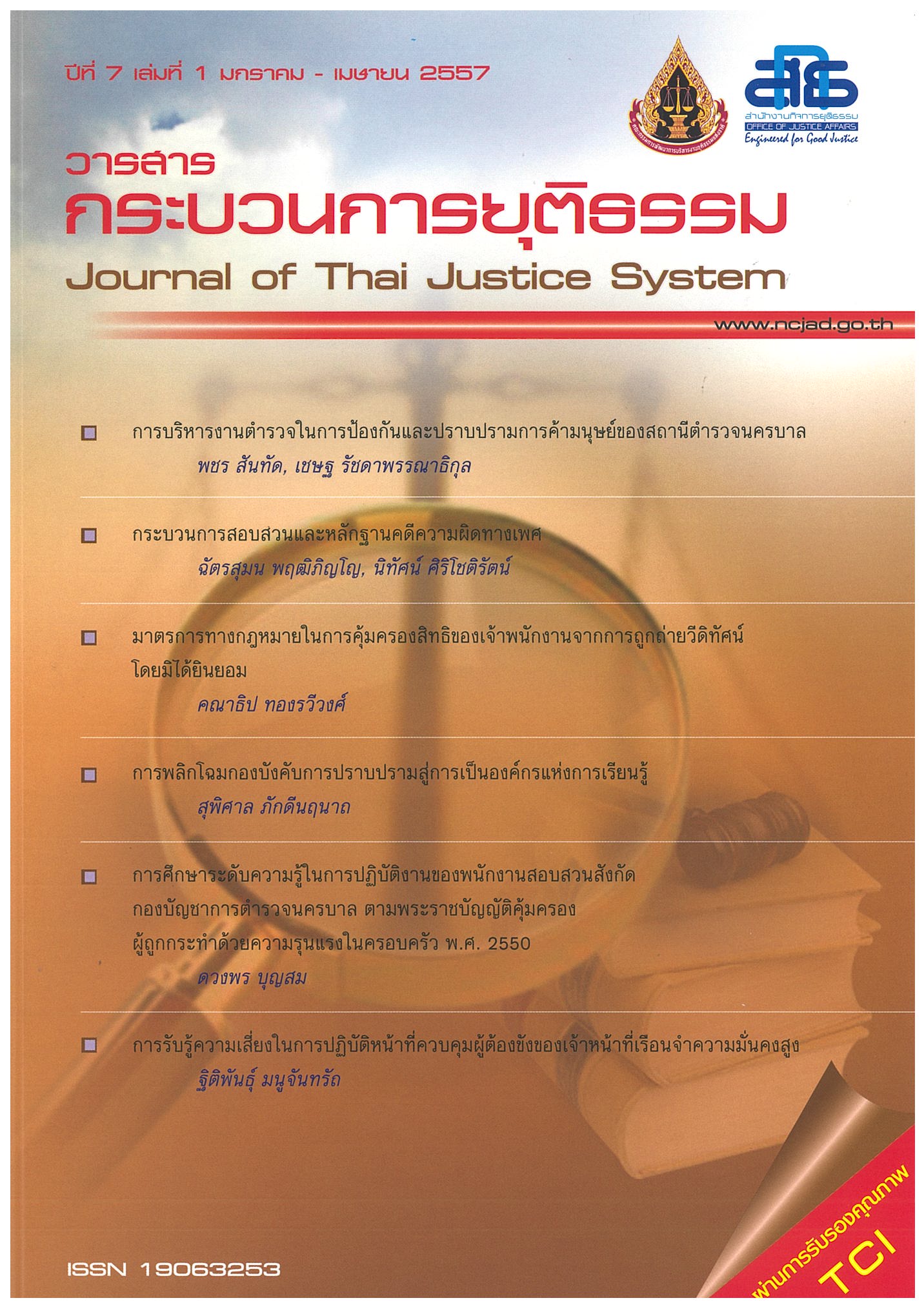การพลิกโฉมกองบังคับการปราบปรามสู่การเป็นองค์การแห่งการเรียนรู้
Main Article Content
บทคัดย่อ
การวิจัยครั้งนี้มีวัตถุประสงค์เพื่อศึกษาแนวทางการพัฒนากองบังคับการปราบปรามสู่องค์กรแห่งการเรียนรู้ โดยศึกษาวิเคราะห์สภาพปัญหา ความต้องการ ้ข้อเสนอแนะ และระดับการเป็นองค์กรแห่งการเรียนรู้และปัจจัยที่มีความสัมพันธ์ต่อการเป็นองค์กรแห่งการเรียนรู้ ในการวิเคราะห์ข้อมูลเชิงปรฺมานโดยเก็บข้อมูลด้วยแบบสอบถามจากกลุ่มตัวอย่างคือ ที่เป็นข้าราชการตำรวจที่ปฏิบัติงาน จำนวน 400 คน จากค่าเฉลี่ย ได้พบว่า ระดับการเป็นองค์กรแห่งการเรียนรู้ของกองบังคับการปราบปราม อยู่ในระดับมากและจากการวิเคราะห์การถดถอยพหุคูณ พบว่า ปัจจัยองค์กร ด้านเทคโนโลยี มีความสัมพันธ์กับการเป็นองค์กรแห่งการเรียนรู้อย่างมีนัยสำคัญทางสถิติในทุกองค์ประกอบทั้งในด้านความมุ่งมั่นในการพัฒนาตนเอง การมีโลกทัศน์กว้างไกล การเรียนรู้เป็นทีมงาน การมีวิสัยทัศน์ร่วม และแนวคิดเชิงระบบส่วนปัจจัยการบริหาร ด้านการจัดการความรู้ มีความสัมพันธ์กับการเป็นองค์กรแห่งการเรียนรู้อย่างมีนัยสำคัญทางสถิติในทุกองค์ประกอบเช่นกันการวิเคราะห์ข้อมูลเชิงคุณภาพซึ่งเก็บรวบรวมด้วยวิธีการสัมภาษณ์เชิงลึกจากกลุ่มผู้เชี่ยวชาญ 7 ท่าน และกลุ่มผู้บริหาร 21 ท่าน สรุปได้ว่า กองบังคับการปราบปรามเป็นองค์กรแห่งการเรียนรู้ระดับปานกลาง และพบว่าภาวะผู้นำมีความสำคัญต่อการส่งเสริมสนับสนุนบุคลากรให้เกิดการเรียนรู้ และพัฒนา องค์กรอย่างต่อเนื่อง เน้นการทำงานเป็นทีมนำไปสู่การแลกเปลี่ยนประสบการณื และแสวงหาความรู้ใหม่ๆ ส่วนนโยบายของสำนักงานตำรวจแห่งชาติ เห็นว่าครอบคลุมภารกิจ
จากสภาพ ปัญหา ความต้องการ ข้อเสนอแนะและนโยบายสำนักงานตำรวจแห่งชาติ ปี 2555 วิเคราะหืและสังเคราะห์จุดแข็ง จุดอ่อน โอกาสและภัยคุกคามที่เกิดขึ้น ผลการวิเคราะห์พบว่มีศักยภาพในระดับสูง เพื่อนำมากำหนดยุทธศาสตร์สำหรับการพัฒนา คือยกระดับการเรียนรู้ภายในองค์กร กระบวนการจัดการความรู้อย่างเป็นระบบ การสร้างเครือข่ายและความร่วมมือ การพัฒนาการเรียนรู้อย่างต่อเนื่อง โดยการดำเนินงานตามยุทธศาสตร์ทั้ง 4 พัฒนาเป็นองค์ความรู้ใหม่ ซึ่งมีความสำคัญต่อการนำไปใช้ในการปฏิบัติงานตามภารกิจให้เกิดประสิทธิภาพ โดยประโยชน์ที่ได้จะเกิดแก่ประชาชนให้มีความผาสุก มีที่พึ่งพาได้ในยามทุกข์ยากอย่างแท้จริง และเป็นการเตรียมความพร้อมต่อการเปลี่ยนแปลงของสถานการณ์ทั้งภายในประเทศ และในระดับสากล
Article Details
ต้นฉบับที่ได้รับการตีพิมพ์ในวารสาร เป็นลิขสิทธิ์ของวารสารกระบวนการยุติธรรม แต่ความคิดเห็นที่ปรากฏในเนื้อหาของบทความในวารสารกระบวนการยุติธรรม ถือเป็นความรับผิดชอบของผู้เขียนแต่เพียงผู้เดียว
เอกสารอ้างอิง
________________(2555). ร่างแผนแม่บทเตรียมความพร้อมรองรับการเข้าสู่ประชาคมอาเซียน ปี 2558. กรุงเทพฯ:สำนักงานฯ.
Aragon-Correa. J. A., Morales, G.,&Cordon-Pozo, E. (2007) Leadership and organizational learning's role on innovation and performance: Lessons from Spain Industrial Marketing Management 36, 349-359.
Argyris, C.,&Schon, D. (1996). Organizational learning II: Theory, method and practice. Reading, MA: Addison Wesley.
Bayraktaroglu, S. (2001). "BirO grenenO rgutUygulamasi (An implementation of a learning organization) Yonetimve EkonomiDergisi (management and economics review)" Celal Bayar University.
Bennett, J. K., & O'Brien, M. J.. (1994) The Building Blocks of the Learning Organization Training. 31(6), 41-49.
Conner, K. R.,&Prahalad, C. K. 1996 A resource-based theory of the firm: knowledge vs. opportunism. Organization ScienceVol. 7(5), 477-501.
Damanpour, F. (1991). Organizational innovation: A meta-analysis of effects of determinants and moderators. Academy of Management Journal. 34, 555-590.
Dishman, P., & Pearson, T. (2003) Assessing intelligence as learning within an industrial marketinggroup: A pilot study. Industrial marketing Management, 32(7), 615-620.
Drucker, P. (1999). Management challenges for the 21st century. Harper Collins Publichers.
Easterby-Smith, M. (1997). Disciplines of organizational learning: contributions and critiques. HumanRelations, 50(9), 1085-1113.
Huber, G. (1991). Organizational Learning: the Contributing Processes and the Literatures. Organization Science. 2(1), 88-115.
Kaplan, R. S., & Norton, D. P. (2004). Strategy Maps Converting Intangible Assests into Tangible Outcome. Massachusetts: Havard Business Scholl Press Boston, Massachusetts.
Kogut, B., & Zandr, U. (1992). Knowledge of the firm, combinative capabilities, and the replication of technology Organization ScienceVol.3(3), 383-397
Krejcie, R. V., & Morgan, D. W. (1970).Determining Sample Size for Research Activities. Education and Psychological Measurement, 30, 607-610.
Linder, F. & Wald A. (2011). Success factors of knowledge management in temporary organizations International Journal of Project Management, 29, 877-888
MArquardt, M. & Reynold, A. (1994). The Global Learning Organization. New York: Irnwin.
McGaw, D., & Watson, G. (1976). Political and Social Inquiry, Arizona: Arizona State University.
Nunnally, J. C., & Bernstein, I. H. (1994). Psychometric Theory. New York: McGraw-Hill.
Sanchez, R., 7 Mahoney, J. T. (1996). Modularity, Flexibility, and knowledge management in product and organization design. Strategic Management Journal, 17, 63-76.
Senge, P. M. (1990). The Fifth Discipline: The Art and Practice of the Learning Organization. Doubleday, 6-11.
Terreberry, S. (1968). The evolution of organizational environments. Administrative Science Quarterly, 12(4), 590-613.
Zahay, D. L., & Handifield, R. B. (2004). The role of learning and technical capabilities in predicting adoption of B2B technologies. Industrial Marketing Management, 33, 627-64`1.


